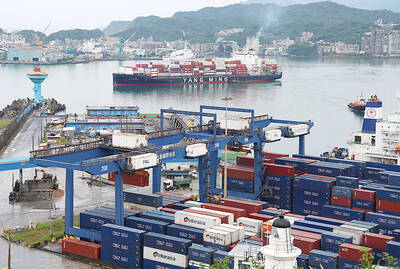Hon Hai Precision Industry Co (鴻海), the world’s largest contract electronics maker, has proposed to spend ¥300 billion (US$2.5 billion) to acquire financially struggling electronics firm Sharp Corp, according to Japan’s Kyodo news agency.
The report posted on Friday said that the proposed acquisition price is about 50 percent higher than the Japanese company’s current market value, indicating that Hon Hai wants to use the good offer to gain the upper hand and win consensus from the Japanese firm during acquisition negotiations.
According to the report, while Hon Hai — known as Foxconn Technology Group (富士康) outside Taiwan — has proposed acquiring Sharp at a high premium, it also wants Sharp’s current management team, including president and chief executive officer Kozo Takahashi, to step down.
Hon Hai would send a team to Sharp to manage the firm, the report said.
Hon Hai also plans to take over the debt shouldered by Sharp to help the firm address its financial problems, the report said.
However, the report also said that Hon Hai has yet to talk with Sharp’s bank creditors.
The report said that Sharp was shouldering about ¥760 billion in debt as of the end of September.
Hon Hai is not the only potential suitor seeking to buy Sharp, the report said, adding that the Innovation Network Corp of Japan (INCJ), which is sponsored by the Japanese government, is studying a buyout of Sharp.
The report said that the INCJ still needs some time to map out a concrete acquisition deal, and the proposal is unlikely to come out until next year, so Hon Hai is taking advantage of the vacuum created to make a deal.
According to the report, the INCJ is discussing whether it would spin off Sharp’s LCD production operations and then integrate the operations with the INCJ’s small and medium-sized flat-panel unit, Japan Display Inc (JDI).
The INCJ owns a 35 percent stake in JDI.
Although Hon Hai proposed spending ¥300 billion to acquire Sharp, the Kyodo report said that the Taiwanese firm’s previous proposal to raise its stake in Sharp’s flatscreen plant, Sakai Display Products Corp in Osaka’s Sakai City, is still valid.
In July 2012, Hon Hai chairman Terry Gou (郭台銘), in a personal capacity, acquired a 37.6 percent stake in the advanced display panel plant from Sharp, which now holds a 37.6 percent share.

CHIP RACE: Three years of overbroad export controls drove foreign competitors to pursue their own AI chips, and ‘cost US taxpayers billions of dollars,’ Nvidia said China has figured out the US strategy for allowing it to buy Nvidia Corp’s H200s and is rejecting the artificial intelligence (AI) chip in favor of domestically developed semiconductors, White House AI adviser David Sacks said, citing news reports. US President Donald Trump on Monday said that he would allow shipments of Nvidia’s H200 chips to China, part of an administration effort backed by Sacks to challenge Chinese tech champions such as Huawei Technologies Co (華為) by bringing US competition to their home market. On Friday, Sacks signaled that he was uncertain about whether that approach would work. “They’re rejecting our chips,” Sacks

Taiwan’s exports soared 56 percent year-on-year to an all-time high of US$64.05 billion last month, propelled by surging global demand for artificial intelligence (AI), high-performance computing and cloud service infrastructure, the Ministry of Finance said yesterday. Department of Statistics Director-General Beatrice Tsai (蔡美娜) called the figure an unexpected upside surprise, citing a wave of technology orders from overseas customers alongside the usual year-end shopping season for technology products. Growth is likely to remain strong this month, she said, projecting a 40 percent to 45 percent expansion on an annual basis. The outperformance could prompt the Directorate-General of Budget, Accounting and

NATIONAL SECURITY: Intel’s testing of ACM tools despite US government control ‘highlights egregious gaps in US technology protection policies,’ a former official said Chipmaker Intel Corp has tested chipmaking tools this year from a toolmaker with deep roots in China and two overseas units that were targeted by US sanctions, according to two sources with direct knowledge of the matter. Intel, which fended off calls for its CEO’s resignation from US President Donald Trump in August over his alleged ties to China, got the tools from ACM Research Inc, a Fremont, California-based producer of chipmaking equipment. Two of ACM’s units, based in Shanghai and South Korea, were among a number of firms barred last year from receiving US technology over claims they have

BARRIERS: Gudeng’s chairman said it was unlikely that the US could replicate Taiwan’s science parks in Arizona, given its strict immigration policies and cultural differences Gudeng Precision Industrial Co (家登), which supplies wafer pods to the world’s major semiconductor firms, yesterday said it is in no rush to set up production in the US due to high costs. The company supplies its customers through a warehouse in Arizona jointly operated by TSS Holdings Ltd (德鑫控股), a joint holding of Gudeng and 17 Taiwanese firms in the semiconductor supply chain, including specialty plastic compounds producer Nytex Composites Co (耐特) and automated material handling system supplier Symtek Automation Asia Co (迅得). While the company has long been exploring the feasibility of setting up production in the US to address